NASA Reveals Three Potential Habitats You Could Live In On Mars
This article is more than 2 years old
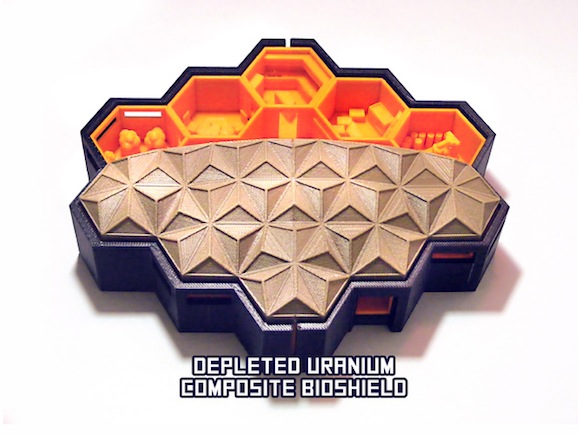 If we, as the collective human race, are ever going to get to Mars, there are some massive challenges that we will have to overcome. Actually getting there is only the first part of the problem, once we arrive on the Red Planet, we’ll have to deal with other issues, like where the hell do we live? Now we have a look at three designs that could, in the future, prove to be habitats for humanity while we vacation on our nearby neighbor.
If we, as the collective human race, are ever going to get to Mars, there are some massive challenges that we will have to overcome. Actually getting there is only the first part of the problem, once we arrive on the Red Planet, we’ll have to deal with other issues, like where the hell do we live? Now we have a look at three designs that could, in the future, prove to be habitats for humanity while we vacation on our nearby neighbor.
NASA has joined forces with MakerBot to issue the Mars Base Challenge, which allows anyone willing to go through the effort the chance to submit their own design for possible Martian domiciles. In doing so, the contestants have to take a number of factor into consideration, like bitterly cold temperatures (down to negative 70 Fahrenheit), the constant, deadly radiation, vicious dust storms, and other things that I probably haven’t even considered that will make life on Mars rather difficult.
After going on for a while, the contest has now finally narrowed the field down to the top three designs. And just to get this out there, anyone could enter this challenge, so take these with a grain of salt, because they’re weren’t necessarily designed by someone who knows what the hell they’re doing. Just a head’s up. That, however, doesn’t mean these can’t serve as an inspiration for space structures, they all do certainly look futuristic and science fiction-esque.
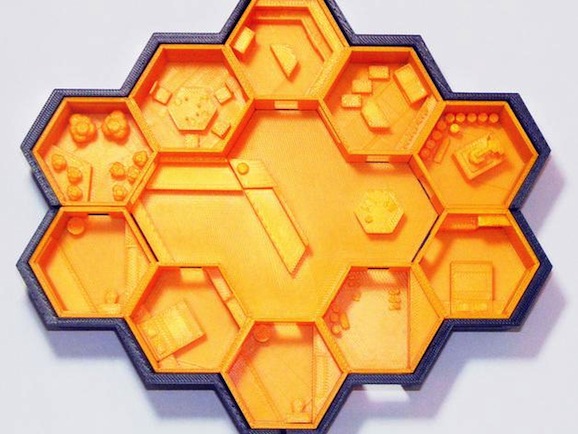 First up is the Queen B. This charming two-bedroom, two-bath Martian apartment is constructed out of tessellated hexagons, to provide a nice, modular approach. The design is intended to mimic living conditions on Earth, thus making life on Mars more appealing, and ideally attracting people who want to live inside a glorified cube on a dusty planet where you can’t go outside without wearing a space suit.
First up is the Queen B. This charming two-bedroom, two-bath Martian apartment is constructed out of tessellated hexagons, to provide a nice, modular approach. The design is intended to mimic living conditions on Earth, thus making life on Mars more appealing, and ideally attracting people who want to live inside a glorified cube on a dusty planet where you can’t go outside without wearing a space suit.
These pieces can be fit together like a puzzle, making for easy construction and additions, should your little alien community need to grow and expand. The compact nature of the design should also cut down on heat loss that would occur with long exposed passageways and halls. And the 60-degree angles of a hexagon fit together much more snug and secure than 90-degrees of a square. It appears very stable.
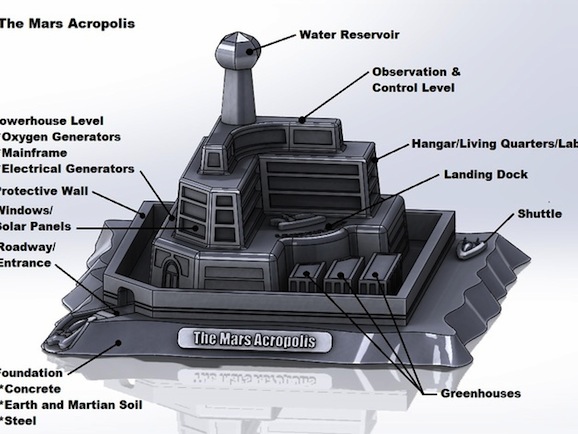 Next up is The Mars Acropolis, which shies away from the more modular, puzzle-themed strategy. This is a three-tiered structure designed to provide an efficient and sustainable habitat on Mars. It contains multiple greenhouses so residents will be able to grow their own food instead of having to truck in supplies on a regular basis, as well as all the pertinent equipment to regulate the internal atmosphere.
Next up is The Mars Acropolis, which shies away from the more modular, puzzle-themed strategy. This is a three-tiered structure designed to provide an efficient and sustainable habitat on Mars. It contains multiple greenhouses so residents will be able to grow their own food instead of having to truck in supplies on a regular basis, as well as all the pertinent equipment to regulate the internal atmosphere.
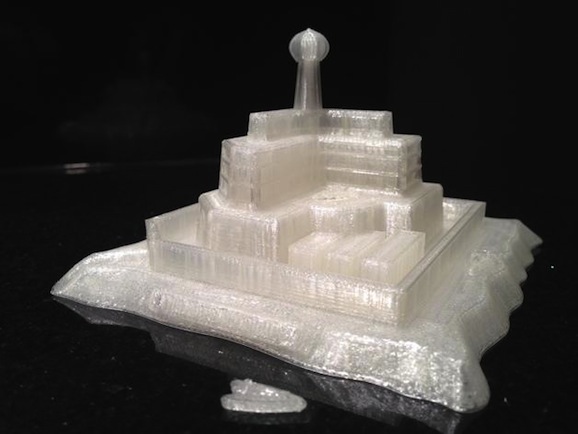 While the Acropolis certainly looks like a more pleasant living environment, it seems problematic for a couple of reasons. First, construction appears to be a speed bump. This seems like something that you would have to build from scratch, rather than a series of prefabricated pods you can just kind of plug in and go. And given the frequent windstorms, a taller structure may not necessarily be the best way to go. It could suffer too much damage to make this a feasible option.
While the Acropolis certainly looks like a more pleasant living environment, it seems problematic for a couple of reasons. First, construction appears to be a speed bump. This seems like something that you would have to build from scratch, rather than a series of prefabricated pods you can just kind of plug in and go. And given the frequent windstorms, a taller structure may not necessarily be the best way to go. It could suffer too much damage to make this a feasible option.
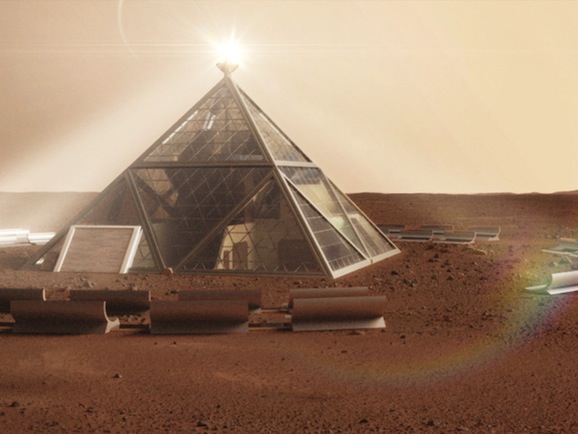 And then there is the Martian Pyramid, which is designed to mimic some of the largest, most durable structures on Earth. And it looks a little bit like the Louvre. The shape should provide stability and protection against external forces, and inside this is designed to be as efficient as possible, combining as many systems in a loop, creating equipment with multiple functions when that can happen.
And then there is the Martian Pyramid, which is designed to mimic some of the largest, most durable structures on Earth. And it looks a little bit like the Louvre. The shape should provide stability and protection against external forces, and inside this is designed to be as efficient as possible, combining as many systems in a loop, creating equipment with multiple functions when that can happen.
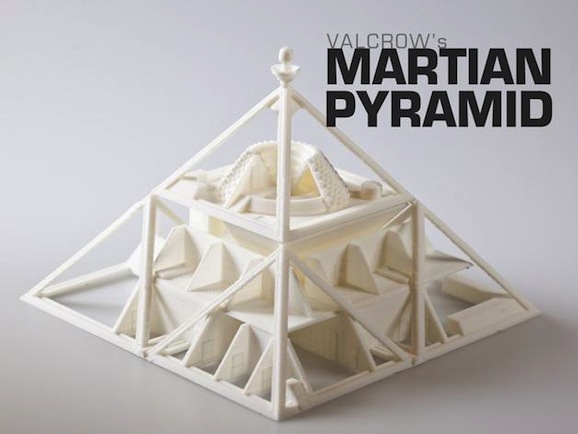 Solar panels will provide heat and energy, and these folks have obviously seen enough sci-fi movies to know that should something happen to the power, the residents will need ready access to things like air and water. As a result, they have conveniently placed these where people can get to them should the need arise. There’s even a small nuclear generator as backup, and this is designed with communal spaces in mind, as well as individual quarters.
Solar panels will provide heat and energy, and these folks have obviously seen enough sci-fi movies to know that should something happen to the power, the residents will need ready access to things like air and water. As a result, they have conveniently placed these where people can get to them should the need arise. There’s even a small nuclear generator as backup, and this is designed with communal spaces in mind, as well as individual quarters.
So there you have it. Should you, at some point in your life, find yourself living on Mars, it’s entirely possible that you could lay your head in one of these three structures, or at least a structure derived from one of these. What do you think, do you have a favorite?












